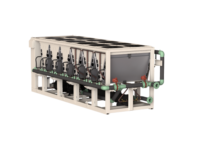“The NBI Study confirms that newly constructed LEED certified buildings use significantly less energy than their conventional counterparts, and that they perform better overall,” said Brendan Owens, vice president of LEED Technical Development, USGBC.
“The report also underscores that monitoring a building’s ongoing operations and maintenance, as required in LEED for Existing Buildings: Operations & Maintenance and ENERGY STAR, is equally important,” continued Owens. “Buildings are complicated systems and achieving and maintaining high performance is a process that requires the ongoing discipline and commitment to green practices. LEED and ENERGY STAR provide building owners and operators with valuable structure to maintain high performance and deliver savings over time.”
Energy savings under the EPA’s ENERGY STAR program are equally impressive: buildings that have earned the ENERGY STAR label use an average of almost 40% less energy than average buildings, and emit 35% less carbon.
But beyond the obvious implications of reduced energy use and reduced carbon emissions, the results from both studies strengthen the “business case” for green buildings as financially sound investments.
According to the CoStar study, LEED buildings command rent premiums of $11.24/sq ft over their non-LEED peers and have 3.8% higher occupancy. Rental rates in ENERGY STAR buildings represent a $2.38/sq ft premium over comparable non-ENERGY STAR buildings and have 3.6% higher occupancy.
And, in a trend that could signal greater attention from institutional investors, ENERGY STAR buildings are selling for an average of $61/sq ft more than their peers, while LEED buildings command a remarkable $171 more per sq ft.
The group analyzed more than 1,300 LEED certified and ENERGY STAR buildings representing about 351 million sq ft in CoStar’s commercial property database of roughly 44 billion sq ft, and assessed those buildings against non-green properties with similar size, location, class, tenancy, and year-built characteristics to generate the results.
“ENERGY STAR is a prerequisite in LEED for Existing Buildings, signaling our strong commitment to the energy savings component of green buildings,” said Owens. “Add to that the additional performance enhancements in LEED around intelligent site selection, water conversation, improved indoor air quality, waste reduction, and smarter materials selections, and it’s easy to understand why owners and tenants are placing a premium on green buildings.”
The NBI study was funded by USGBC with support from the EPA and can be accessed at: http://www.usgbc.org/DisplayPage.aspx?CMSPageID=77#usgbc_publications.




